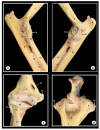Anatomic Study of the Elbow Joint in a Bengal Tiger (Panthera tigris tigris) Using Magnetic Resonance Imaging and Gross Dissections
- PMID: 31805734
- PMCID: PMC6940883
- DOI: 10.3390/ani9121058
Anatomic Study of the Elbow Joint in a Bengal Tiger (Panthera tigris tigris) Using Magnetic Resonance Imaging and Gross Dissections
Abstract
The objective of our research was to describe the normal appearance of the bony and soft tissue structures of the elbow joint in a cadaver of a male mature Bengal tiger (Panthera tigris tigris) scanned via MRI. Using a 0.2 Tesla magnet, Spin-echo (SE) T1-weighting, and Gradient-echo short tau inversion recovery (GE-STIR), T2-weighting pulse sequences were selected to generate sagittal, transverse, and dorsal planes. In addition, gross dissections of the forelimb and its elbow joint were made. On anatomic dissections, all bony, articular, and muscular structures could be identified. The MRI images allowed us to observe the bony and many soft tissues of the tiger elbow joint. The SE T1-weighted MR images provided good anatomic detail of this joint, whereas the GE-STIR T2-weighted MR pulse sequence was best for synovial cavities. Detailed information is provided that may be used as initial anatomic reference for interpretation of MR images of the Bengal tiger (Panthera tigris tigris) elbow joint and in the diagnosis of disorders of this region.
Keywords: Bengal tiger (Panthera tigris tigris); anatomy; elbow joint; magnetic resonance imaging.
Conflict of interest statement
The authors declare no conflict of interest.
Figures





References
-
- Snaps F.R., Saunders J.H., Park R.D., Daenen B., Balligand M.H., Dondelinger R.F. Comparison of spin echo, gradient echo and fat saturation magnetic resonance imaging sequences for imaging the canine elbow. Vet. Radiol. Ultrasound. 1998;39:518–523. doi: 10.1111/j.1740-8261.1998.tb01642.x. - DOI - PubMed
LinkOut - more resources
Full Text Sources

